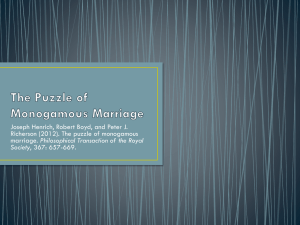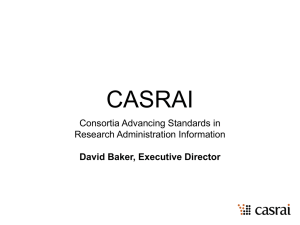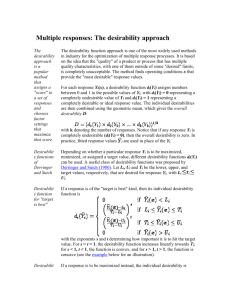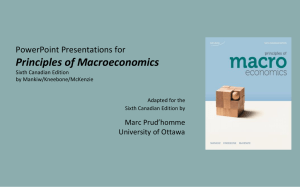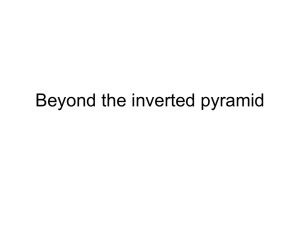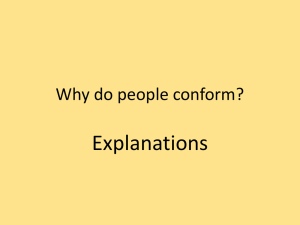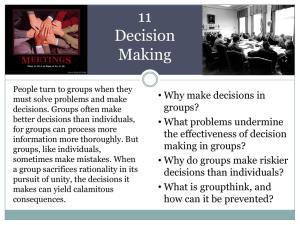Time perspective as normative construct
advertisement
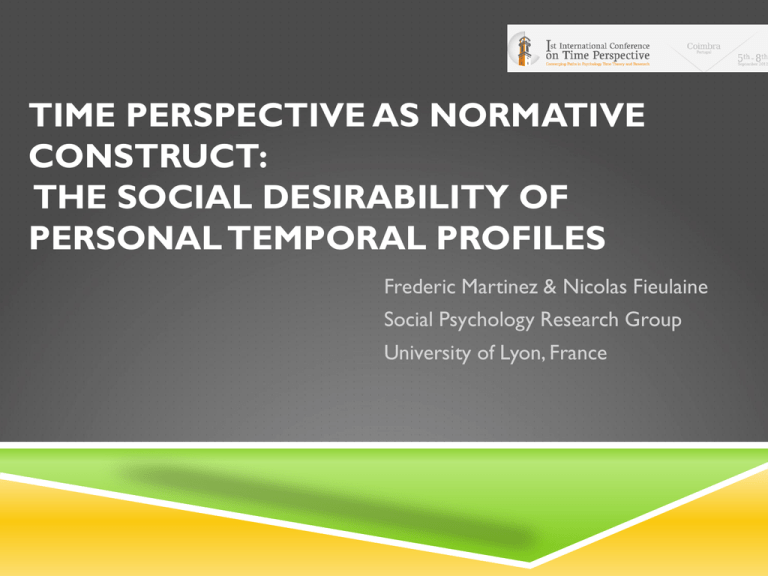
TIME PERSPECTIVE AS NORMATIVE CONSTRUCT: THE SOCIAL DESIRABILITY OF PERSONAL TEMPORAL PROFILES Frederic Martinez & Nicolas Fieulaine Social Psychology Research Group University of Lyon, France CORRELATES OF TP Time perspective as a dispositional construct defined as the totality of the views one have on his past, his present and his future (Lewin, 1942; Zimbardo & Boyd, 1999) A substantial body of research has accumulated that was designed to determine the correlates of TP (behaviours, attitudes, well-being…) From this body of empirical investigations has come evidence that TP dimensions are diversely related to positive or negative outcomes Future and past positive TP were generally related to positive outcomes (well-being, academic achievement, higher income…) Past-negative and present fatalistic were related to négative outcomes (depression, anxiety, suicidal ideation…) Present-hedonistic was related to risky behaviors and substance use, but also to positive relations with others and happiness Various authors has proposed the possibility of a “Balanced time perspective” (Boniwell & Zimbardo, 2004; Boyd & Zimbardo, 2005; Boniwell & al. 2010) Moderate to high FTP and PPTP, Moderate PHTP, Low PFTP and PNTP This BTP was related to well-being, Happiness, Quality of life… AN EXPLANATION BIAS ? Explanations almost always take an internal form, framed in terms of individuals' ability, capacity or competence But there could be also a contextual explanation of why people with BTP feel so good… This interpretation proposes the existence of a norm valuing some temporal profiles and devaluing others. Social pressures from the environment are applied to the individual whose actions are guided by attempts to gain social approval and avoid social disapproval. If individuals with devalued temporal profiles face social sanctioning, this may be a source for the observed outcomes If individuals are aware of such a norm, it may contribute to a desirability bias in the measure of TP DESIRABILITY AND UTILITY OF PERSONALITY TRAITS Literature on social judgment has shown that two dimensions seem to organize people’s perceptions of people and objects (Judd & al., 2005). The first relates to what makes someone likable and socially attractive, and includes traits such as nice, likable, aggressive, and selfish. We refer to this dimension as “social desirability” (Beauvois, 2003; Rosenberg et al., 1968) or “friendliness” (Wiggins, 1979). The second dimension includes traits such as competent, smart, and idiot and has been defined as “competence” (Fiske et al., 2002; Judd et al., 2005) or “social utility” (Dubois & Beauvois, 2005). Those dimensions may support differential judgments of temporal profiles People high on PHTP may be judged as desirable, but not competent People high on FTP may be judged as competent, but not friendly AIMS OF THE STUDY To evaluate the social judgments related to individuals’ time perspective and to temporal profiles To assess the knowledge people have on these judgments To test the relative weight of desirability and utility To explore the concrete impacts of these judgments on behaviors Using the three paradigms proposed by Jellison & Green (1981) Social Comparison : Self vs average others (people depict themselves more positively than typical or average others, Festinger, 1954) Self-presentation : Self-enhancement vs Self-depreciation Social approval : Judging a fictious respondent METHOD ZTPI scale – Short form 15 items measuring TP on the five dimensions (3 per dimension; α ≥.70) Social comparison subjects were asked to complete a 15-item ZTPI scale in terms of “their own personal responses to the items” Then they were given a second, blank form and were instructed to complete this questionnaire in a way that they would expect "the average undergraduate" to respond / N= 46; Mage = 21,7; SD=4,23 Self-presentation Subjects were asked to answer the ZTPI in such a way as to generate a positive image of themselves (self-enhancement strategy) versus a negative image of themselves (self-depreciation strategy; order reversed) / N=51; Mage=20,1; SD=1,40 Social approval Subjects were told that they would read a personality test that had been previously completed by a student, form an impression of the student, and then indicate their impression by rating the individual on traits related to desirability (“pleasant,” “likable”, “honest”; α=.75) and utility (“ambitious”, “conscientious”, “smart”α=.70). Indicate expectations towards the individual (will be successful; will obtain high Grade points; deserve to be supported; would be accepted as a member of my group; would be a friend of mine; would be nice to meet) N=279; m âge=20,88 ; SD= 3,91 SOCIAL COMPARISON *** 4 * 3.79 3.76 3.59 Students attribute greater scores on PH, PP and PF to the average student than to themselves 3.5 3.32 3.29 3.39 3.26 3.49 * 3 2.44 2.5 2.05 2 1.5 Theoretically, these dimensions are less socially valued (PIP effect, Codol, 1973) 1 0.5 0 PN PH F Self Average PP PF SELF PRESENTATION When the incentive to create approval is given, subjects scored higher on PH, F and PP. When the incentive to create disapproval is given, subjects scored higher on PN & PF. 5 4.5 4 4.32 4.23 3.78 3.85 3.56 3.5 3 2.5 2.51 2.69 2 1.78 1.71 1.52 1.5 1 0.5 0 PN PH Negative Enhancement F PP PF Positive Depreciation all p<.001 (between conditions) THE PROFILES 5 Balanced (Normative): High F/Above average PP & PH/Low PN & PF Counter-normative: High PF & PN/ Low PP & F/Beyond average PH Future-oriented: High F/above average PN, PP & Low PH Hedonistic: High PH/above average PN, PF & PP/Low F 4.5 4 3.5 3 PN PP 2.5 PH PF 2 F 1.5 1 0.5 0 Normative Counter Normative Future Hedonistic SOCIAL APPROVAL Stimulus persons received more social approval on utility when TP profile is normative or future oriented. Hedonistic profile is judged as desirable, but not competent Counter-normative profile is rejected particularly on the utility dimension 8 7.6 7 5.7 6 5.5 5.3 5.8 4.9 5 4.5 4 3 2.6 2 1 0 Counter Normative Contre Normatif Future Futur Utilité Hedonistic Hédoniste Normative Normatif Désirabilité all p<.001 (between and within profiles; except red line) DESIRABILITY 7.00 Hedonistic profile is more desirable than the future one 6.00 Normative profile is the more valuated profile on desirability dimension 4.00 5.00 Friend Pleasant Contact 3.00 2.00 1.00 0.00 Counter ContreNormative Normatif Future Futur Hedonistic Hédoniste Normative Normatif UTILITY 8.00 Success is expected for future and normative profiles, not for hedonistic and counter normative 6.00 Success 5.00 Axis Title People have fewer intention to provide help or support to those who are not expected to success, and the don’t want these “losers” to join their groups 7.00 Good notes 4.00 Support 3.00 Member 2.00 1.00 0.00 Counter Normative Contre Normatif Future Futur Hedonistic Hédoniste Normative Normatif CONCLUSIONS As expected, some TP dimensions are more valued than others Social desirability impacts answers to ZTPI. Scores not only reflect individuals personality, but also the way the manage their social identity Subjects are aware of the differential social value related to the temporal dimensions Subjects use this knowledge to judge other students When profiles have fewer value on utility dimension, less success is expected, and this lack of success is reinforced by the lesser support the “losers” receive and the social exclusion they face When studying positive or negative effects of TP, we might consider the role of social pressure and sanctioning There is, at least partly, an external explanation of the lower success in life of people with some temporal profile THANKS FOR YOUR ATTENTION Nicolas.fieulaine@univ-lyon2.fr


